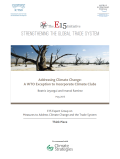In the wake of the Copenhagen Accord in 2009 and amid frustration with the slow pace of the United Nations Framework Convention on Climate Change (UNFCCC) talks, a number of bilateral and plurilateral efforts and technology initiatives has been launched to deal with international climate policy. Bilateral efforts such as the November 2014 joint announcement between the United States (US) and China have provided welcome momentum. These minilateral efforts, together with the broader multilateral ones, constitute the emerging “regime complex” for climate change. In such a world, ambition in climate action must come from national governments as well as from international agreements. For promoting such ambition, key tools include market-based mechanisms that cap emissions of carbon dioxide and other global warming pollutants, and allow nations and firms that reduce emissions below capped levels to save, sell, and trade surplus units of allowable emissions. Such systems are in effect today in more than 50 countries, states, cities, and provinces where almost a billion people live.
In the debate on climate change, methods of producing products and energy are of paramount importance. While the product or the form of energy resulting may be the same, diverging production processes and methods of production may have a critical impact on climate change mitigation, and environmental and human concerns in general. Some may be detrimental, some may be beneficial. They vary from each other, notwithstanding that the final products cannot be distinguished from each other. This paper explores the extent to which renewable energy and non-renewable energy, in particular based on fossil fuels, may be regulated, labelled, or taxed differently, or whether the likeness of the product prohibits doing so in international trade law relating to production and process methods (PPMs). In doing so, the paper mainly focuses on the production of electricity from fossil fuels (coal, oil, and gas), atomic energy, and renewable energy (hydropower, thermal power, wind, solar and tidal energy, and biomass).

Despite diverse efforts in the past two decades, countries have not been able to create an international climate change regime that effectively addresses the challenges at stake. Meanwhile, the Arctic Ocean keeps melting, an area the size of Costa Rica is lost to deforestation every year, and low-lying islands could disappear by 2050 due to a rise in sea level. There are several other huge challenges posed by climate change, which urgently call for serious international action.
The aim of this paper is to provide a critical review of the literature on the econometric analyses of firm-level determinants to eco-innovation. The review reveals some gaps in knowledge. First, an integrated theoretical framework which merges the insights from different approaches is missing. Second, the influence of some variables is still unsettled (demand-pull and cost-savings), whereas others have hardly been included in previous analyses (internal and international factors). Third, studies on the drivers to eco-innovation versus general innovation are relatively scarce with respect to those on the drivers to eco-innovation in general. Fourth, analyses of the relevance of different determinants to eco-innovation for distinct eco-innovator and eco-innovation types have largely been missing. Fifth, studies on middle-income and developing countries are still scarce. Sixth, the econometric analyses have relied on microeconometric methods based on cross-section data (mostly logit and probit models), whereas the use of panel data is virtually absent.
Outsourced emissions are a major loophole in current efforts to tackle climate change and build a green economy. International flows of carbon embedded in trade have grown considerably since the 1992 Rio summit, with developed northern nations benefiting unjustly from effectively outsourcing pollution to developing southern states. The world needs to agree to the principle of Clean Trade Agreements. These arrangements, negotiated between states and regions, would come to replace Free Trade Areas and build mutually-agreed carbon constraints into the terms of trade. Clean Trade Agreements would aim to halt the ‘race to the bottom’ witnessed as globalisation has unfolded – where industry invariably migrates to regions with the least stringent environmental regulations – and reverse the growth in outsourced emissions.
